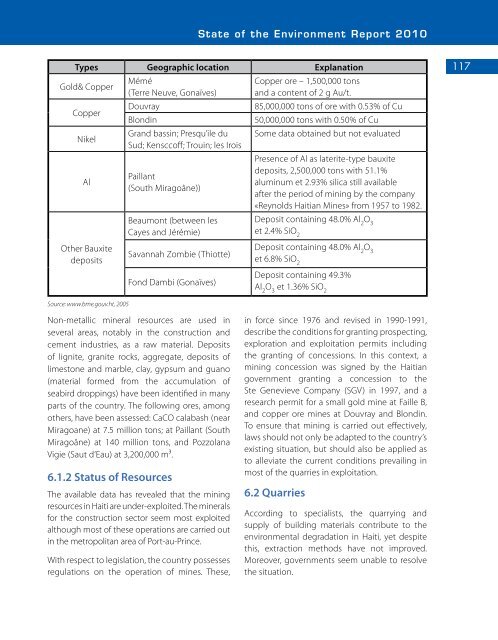GEO Haiti 2010
GEO Haiti 2010
GEO Haiti 2010
Create successful ePaper yourself
Turn your PDF publications into a flip-book with our unique Google optimized e-Paper software.
State of the Environment Report <strong>2010</strong><br />
Types Geographic location Explanation<br />
Gold& Copper<br />
Copper<br />
Nikel<br />
Al<br />
Mémé<br />
(Terre Neuve, Gonaïves)<br />
Douvray<br />
Blondin<br />
Grand bassin; Presqu’ile du<br />
Sud; Kensccoff; Trouin; les Irois<br />
Paillant<br />
(South Miragoâne))<br />
Beaumont (between les<br />
Cayes and Jérémie)<br />
Copper ore – 1,500,000 tons<br />
and a content of 2 g Au/t.<br />
85,000,000 tons of ore with 0.53% of Cu<br />
50,000,000 tons with 0.50% of Cu<br />
Some data obtained but not evaluated<br />
Presence of Al as laterite-type bauxite<br />
deposits, 2,500,000 tons with 51.1%<br />
aluminum et 2.93% silica still available<br />
after the period of mining by the company<br />
«Reynolds <strong>Haiti</strong>an Mines» from 1957 to 1982.<br />
Deposit containing 48.0% Al 2<br />
O 3<br />
et 2.4% SiO 2<br />
117<br />
Other Bauxite<br />
deposits<br />
Savannah Zombie (Thiotte)<br />
Fond Dambi (Gonaïves)<br />
Deposit containing 48.0% Al 2<br />
O 3<br />
et 6.8% SiO 2<br />
Deposit containing 49.3%<br />
Al 2<br />
O 3<br />
et 1.36% SiO 2<br />
Source: www.bme.gouv.ht, 2005<br />
Non-metallic mineral resources are used in<br />
several areas, notably in the construction and<br />
cement industries, as a raw material. Deposits<br />
of lignite, granite rocks, aggregate, deposits of<br />
limestone and marble, clay, gypsum and guano<br />
(material formed from the accumulation of<br />
seabird droppings) have been identified in many<br />
parts of the country. The following ores, among<br />
others, have been assessed: CaCO calabash (near<br />
Miragoane) at 7.5 million tons; at Paillant (South<br />
Miragoâne) at 140 million tons, and Pozzolana<br />
Vigie (Saut d’Eau) at 3,200,000 m³.<br />
6.1.2 Status of Resources<br />
The available data has revealed that the mining<br />
resources in <strong>Haiti</strong> are under-exploited. The minerals<br />
for the construction sector seem most exploited<br />
although most of these operations are carried out<br />
in the metropolitan area of Port-au-Prince.<br />
With respect to legislation, the country possesses<br />
regulations on the operation of mines. These,<br />
in force since 1976 and revised in 1990-1991,<br />
describe the conditions for granting prospecting,<br />
exploration and exploitation permits including<br />
the granting of concessions. In this context, a<br />
mining concession was signed by the <strong>Haiti</strong>an<br />
government granting a concession to the<br />
Ste Genevieve Company (SGV) in 1997, and a<br />
research permit for a small gold mine at Faille B,<br />
and copper ore mines at Douvray and Blondin.<br />
To ensure that mining is carried out effectively,<br />
laws should not only be adapted to the country’s<br />
existing situation, but should also be applied as<br />
to alleviate the current conditions prevailing in<br />
most of the quarries in exploitation.<br />
6.2 Quarries<br />
According to specialists, the quarrying and<br />
supply of building materials contribute to the<br />
environmental degradation in <strong>Haiti</strong>, yet despite<br />
this, extraction methods have not improved.<br />
Moreover, governments seem unable to resolve<br />
the situation.

















